How To Find Easy Keywords In The Different Niches (Air Fryer, Pets & Travel)
Georgi Todorov

In SEO and content marketing, each niche is unique, leading to variations in keyword research methods. Particularly, the quest for attainable keywords differs across niches.
Nonetheless, there are universal strategies for identifying easy and profitable keywords that apply across niches. We’ve covered this topic before, but now, we’ll focus on specific niches.
Our selection includes the travel, air fryer, and pet niches, which are both in demand and of interest to our users.
In this article, we’ll identify 10-15 accessible keywords in each of these niches, demonstrating the process with the help of LowFruits.
How to Find Easy Keywords in the Travel Niche
The travel niche is one of the most saturated industries.
The competition is fierce, which means that domain authority and backlinks are considered to be kings.
Despite that, it’s still possible to find keywords that you can rank for with a relatively new website or one with a low domain authority.
Here’s our keyword research process for the travel niche:
Step #1: Come up with the seed keyword(s)
As a travel writer, you probably have an idea of which locations you want to focus on.
Do not worry – the process is going to be the same for every location, but you need to have a location in mind.
For this example, we will find easy keywords for one of the most saturated travel topics – London!
Our seed keyword will be ”london”. If you are planning to research keywords on more cities, the seed keywords will be the name of the city or the name of the country.
Step #2: Input the seed keyword into LowFruits’ KWFinder
Next up, we are ready to input our seed keyword into LowFruits.
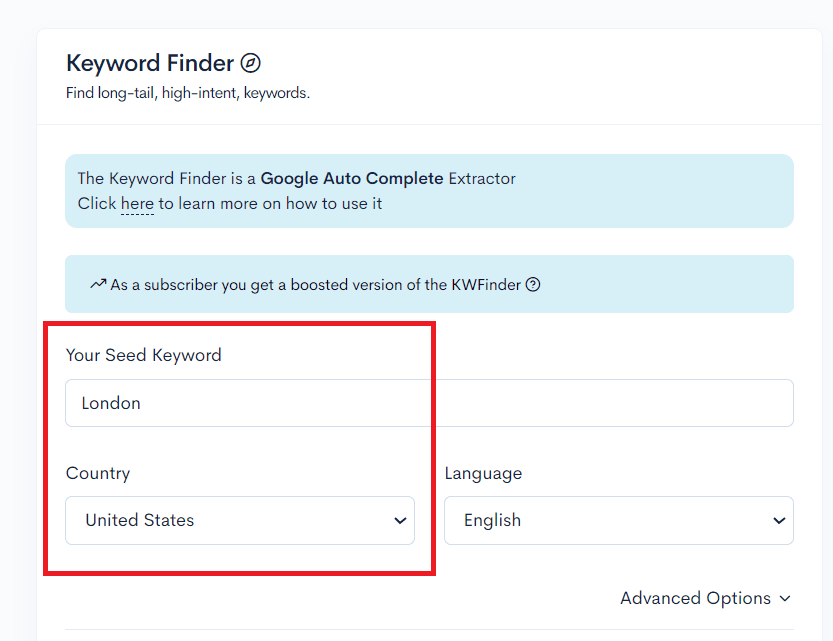
And with the travel niche, we are already seeing our first caveat: which location should we get data from?
After all, people from across the world travel to London. There is data from other locales as well.
In this case, what matters is that we will write our article in English for English speakers.
Brazilians or Koreans are not going to read an English guide on London.
This is why we will put our focus on the US market, as its volumes are bigger than the UK’s and Australia’s.
That means we will be able to find out more keywords than if we targeted the UK or Australia.
But before we proceed, we want to click on ”Advanced options” and select ”extract PAA queries”.

These are the ”People Also Ask” questions that appear on the SERPs. They usually contain plenty of low-difficulty keywords that we can target.
Then, we are presented with 8831 keyword ideas:

Step #3: Select parent topics and apply filters
After we are presented with the data, you should begin by clicking ”fetch volume” at the upper right of the screen.
When we’ve got all of the search volume data, we want to start removing the keyword topics that we are not interested in:
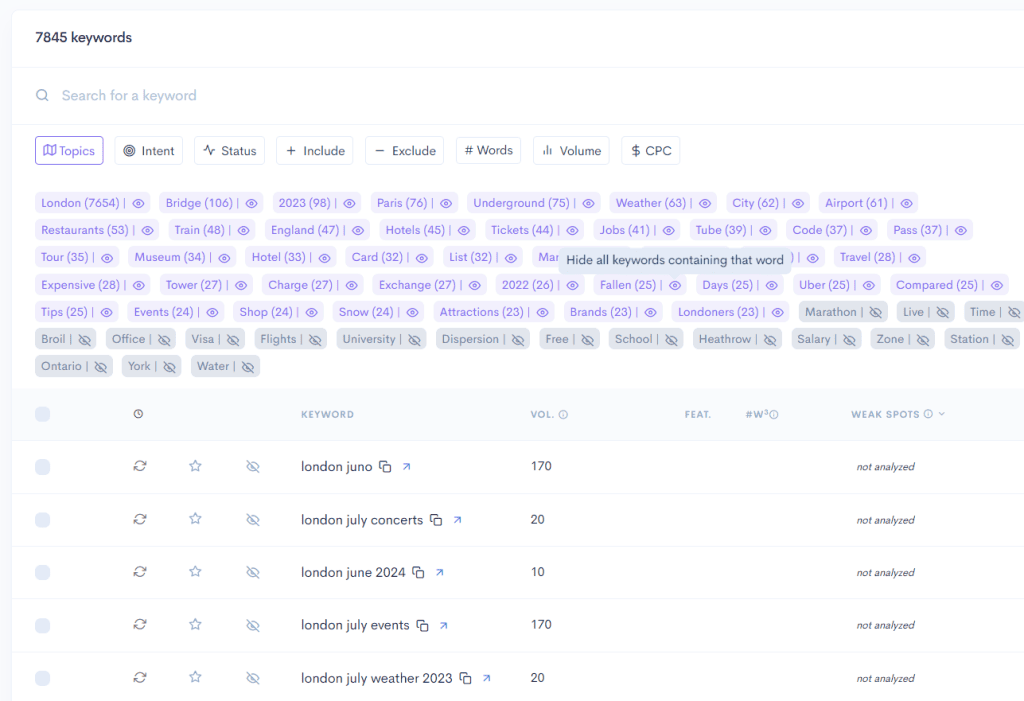
For example, we do not want to write about salaries or Ontario.
It’s also possible to choose which keyword topic you want to see:
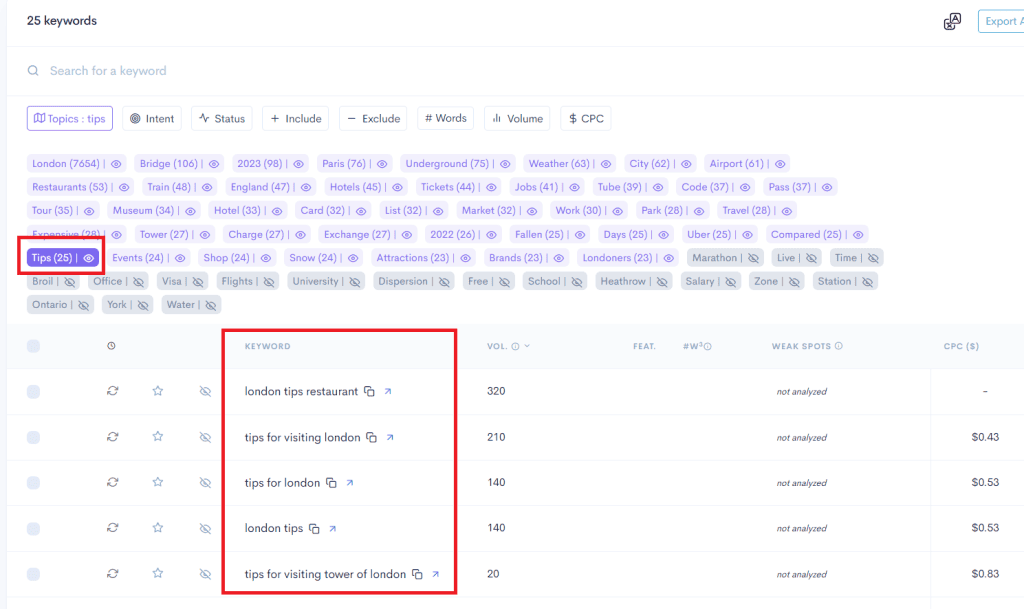
We can also filter by search intent.
Particularly for the travel niche, comparison keywords are particularly useful usually not very hard to rank for.

We will stick with the 137 comparison keywords as we want to have a little variety of keywords.
Step #4: Bulk analyze keywords SERPs with LowFruits
You can select all of the keywords that you want to analyze (in our case, the 137 comparison keywords) and analyze their SERPs with LowFruits.
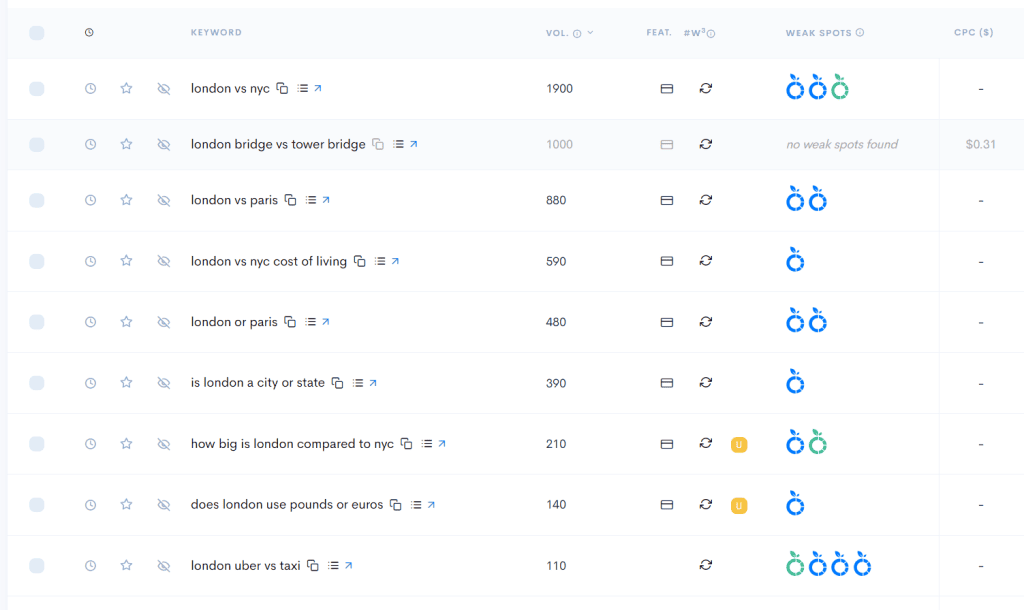
And look at that – we were able to find plenty of keywords with weak spots.
The way we define weak spots:
- Green fruits – websites that have a domain authority of less than 20 (number can be customized) ranking on 1st page
- Blue fruits – user-generated content or forums, such as Reddit or Quora ranking on 1st page
We were able to find keywords that have weak competition on the SERPs.
We can also extract the average word counts and filter by the ideas that have the weakest competition ranking on the 1st page.
Here is the result:
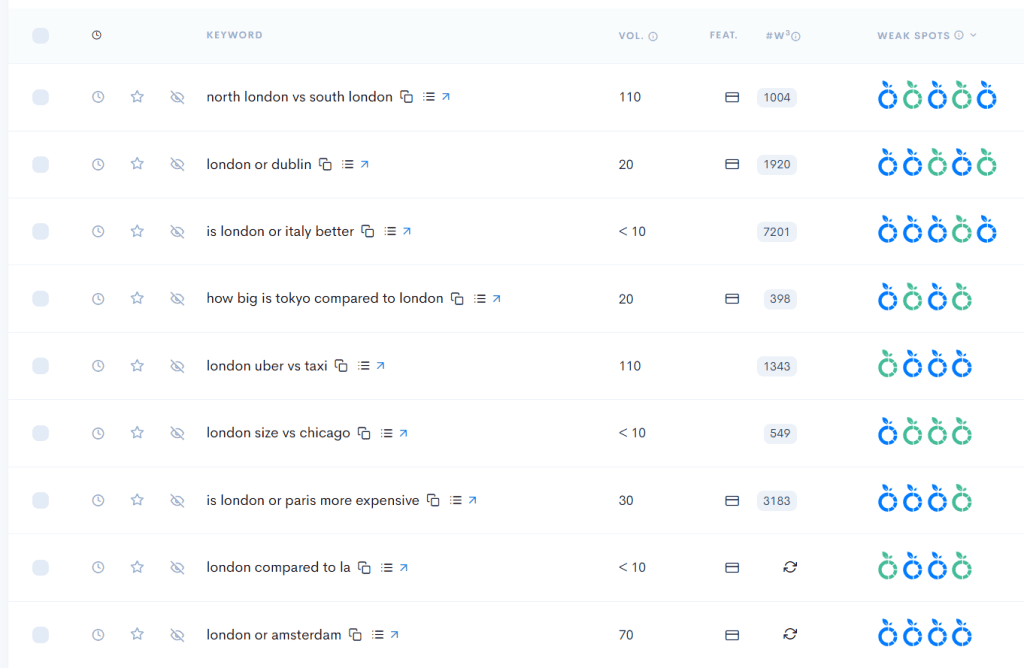
We were able to generate a total of 109 keyword ideas that had weak competitors ranking on the 1st page for London comparisons.
Step #5: Find keywords not optimized by competitors
Sometimes competitors rank for keywords that they have not actively pursued.
And they pose the greatest ranking opportunity for newer websites.
This is why we will go keyword by keyword and see which keyword has ”not found in title” on LowFruits with it.
After clicking on the first 3 keywords and seeing that the competitors have optimized for them, I was able to spot that ”how big is tokyo compared to london” has not been optimized for in the title tags.

If you repeat that process for all of the keywords, you will be able to spot which keywords to prioritize.
Naturally, you want to start with the under-optimized keywords, but the keywords that were optimized for weak domains can also be pursued.
How to Find Easy Keywords in the Air Fryer Niche
Keyword research in the cooking niche is one of the most requested ones since it’s a topic with growing popularity.
And even though the competition is not as fierce as in the travel niche, we cannot be pursuing short-tail keywords and hoping for the best.
Here’s how we would go on to find easy keywords in the cooking niche:
Step #1: Generate seed keywords from products or topics
Let’s say that we want to research keywords around the Air Fryer niche.
Our seed keyword is going to be ”air fryer” in this case.
If you have any other products on your website, then their product names will be the seed keyword.
Step #2: Input the seed keyword in LowFruits’ KWFinder
The next step is to input our seed keyword ”air fryer” into LowFruits.
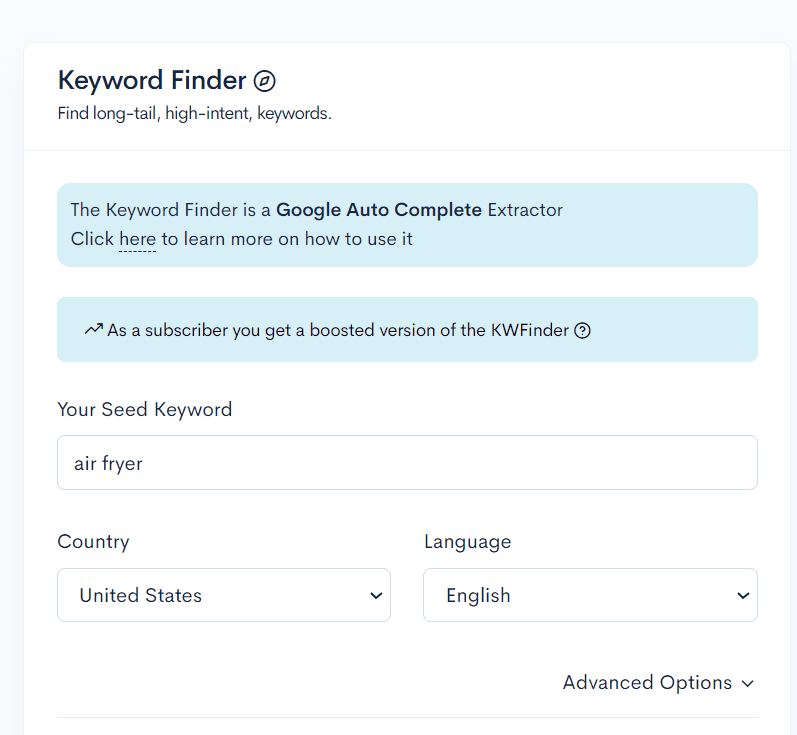
You can also select the ”advanced options” and choose to include the People Also Ask (PAA) queries for some bonus questions.
And just like that, we were able to generate 7983 keyword ideas:

Step #3: Choose keyword topics and apply filters
Begin by fetching the volume of all of the keywords in the top right corner.
After that, we want to choose the keyword topics that we do not want to research, and then decide on which one we want to focus on:

In this case, we are not interested in branded keywords such as ”Xiaomi” or ”Tefal”.
I’m personally interested in the ”Recipes” that we can see to be cooked with an air fryer.
If I were looking for profitable keywords, then I would have selected ”pre-purchase” as my intent and then clicked on something like ”Chicken”:
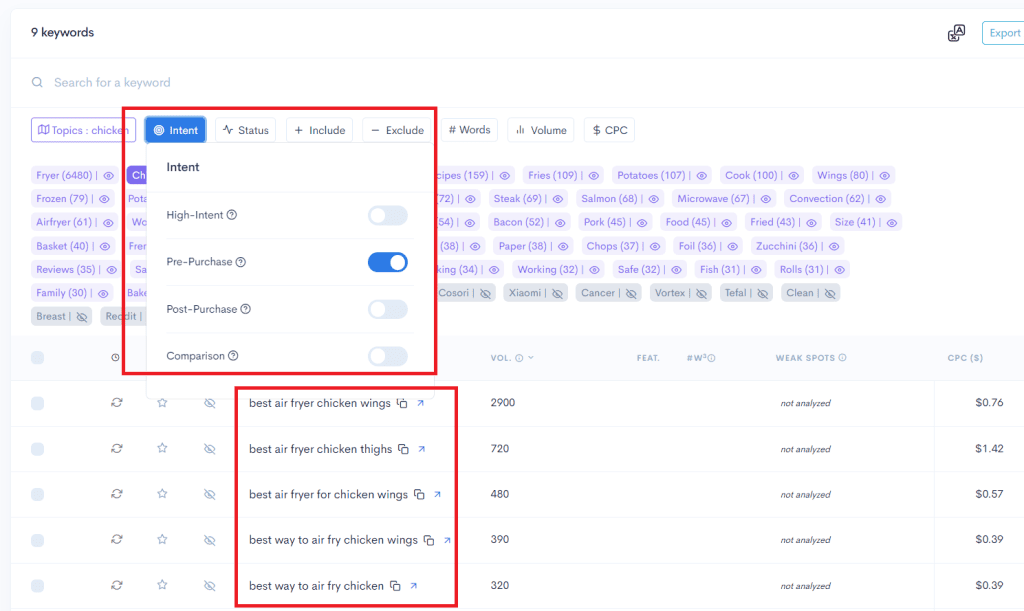
But for the remainder of this research, we will stick with ”Recipes”.
Step #4: Bulk analyze keywords SERPs with LowFruits
We can proceed to analyze the SERPs of the 72 ”Recipes” keywords that we were able to find for air fryers.
Our next step is to find out which keywords have weak domains ranking for it on the first page:
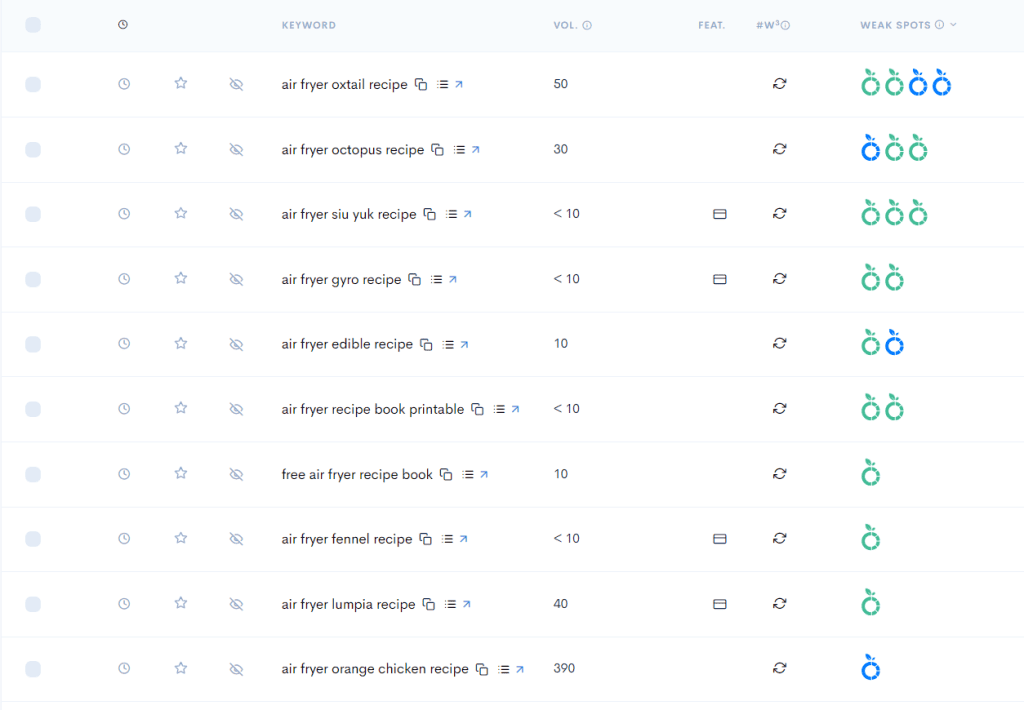
If you remember from the travel niche section, here are what the different fruits signal:
- Green fruits – Sites that have a domain authority of less than 20 (number can be customized) ranking on 1st page
- Blue fruits – User-generated content or forums, such as Reddit or Quora ranking on 1st page
We can effectively go after the keywords that have green or blue fruits, which is why it makes sense to filter by the fruits.
For every keyword that you analyze inside of LowFruits, it will cost you 1 credit.
That means if you are filtering down the keywords that you want to analyze based on the keyword topics or search intent, you will not spend more than 100-150 credits per keyword research.
Tip: Before analyzing keywords, review and click “hide” on those you’re not interested in to save credits.
I’m personally not very satisfied with the Recipe results, so let’s try going for the ”Chicken” keyword group and analyze an additional 350 keywords:

We were able to find a greater variety of low-hanging fruits as well as higher volume keyword ideas to go after.
Step #5: Find competitors’ unoptimized keywords
Now all that is left is to prioritize the keywords on which we should go after based on how easy it will be to rank for them.
Naturally, the keywords that have the highest amount of fruits should be the first ones we should prioritize, but before that, there is another trick.
We want to see which keywords have not been optimized for in the product titles.
After clicking on keyword after keyword, I was able to find that this question has not been optimized for in any of the 1st page’s titles:
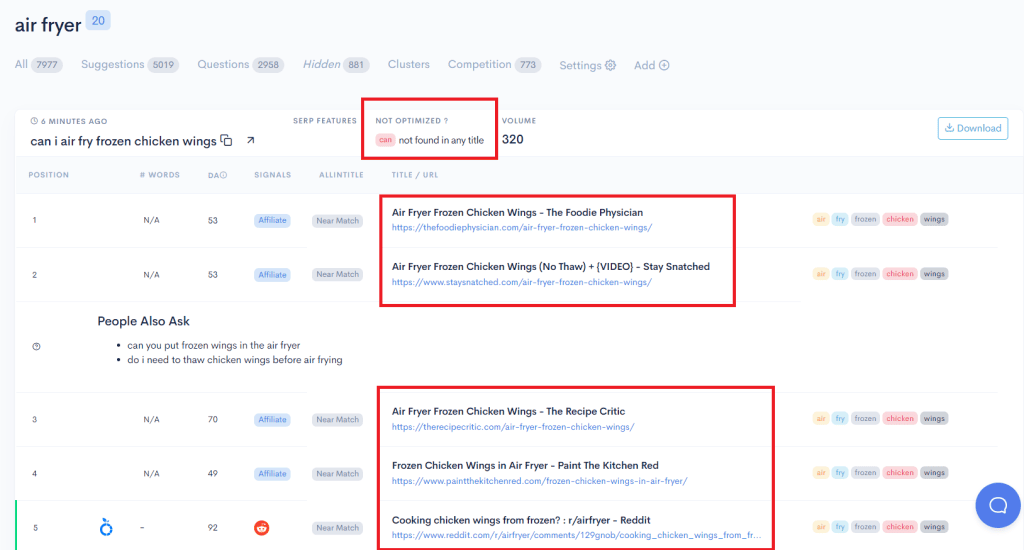
And it’s a relatively high volume keyword as well, with a search volume of 320.
These are the kinds of keywords that nobody targeted with their titles but they ranked for it as a secondary keyword.
You can repeat that process for all of the keywords that have weak domains ranking on the first page.
And this is how we were able to come up with 110 keyword ideas for the air fryer niche.
Upon further filtering (e.g., not optimized for in the title), we can decide on the first 10-15 to target.
How to Find Easy Keywords in the Pets Niche
The pet niche is considered one of the best niches to go for since it’s not really saturated, and there are a lot of affiliate opportunities.
But do not get me wrong – there’s no such thing as having it easy in the pet’s niche.
We will still have to be smart about how we conduct our keyword research.
Here is how we would approach finding easy keywords for the pet niche:
Step #1: Generate seed keywords from products or pets
The seed keyword should be based on the pet product that you are trying to sell or on the type of pet that you will be writing for.
For example, let’s take ”dog” as our seed keyword, as I’m more of a dog person.
But in the pets niche, you want to have multiple seed keywords. This is why my seed keywords will be the different dog breeds I’m interested in.
That would be ”german shepherd” and ”bulldog”.
For you, it could be ”cat” and ”ragdoll”, again, depending on your focus.
Step #2: Enter the seed keyword in LowFruits’ KWFinder
We would have to do individual keyword research for the 3 seed keywords, but in this article, I will be focusing only on the seed keyword ”dog” since the approach is the same for the other 2.
We input the seed keyword into LowFruits:

It’s also recommended that you click on ”Extract People Also Ask (PAA) queries” from the advanced options:
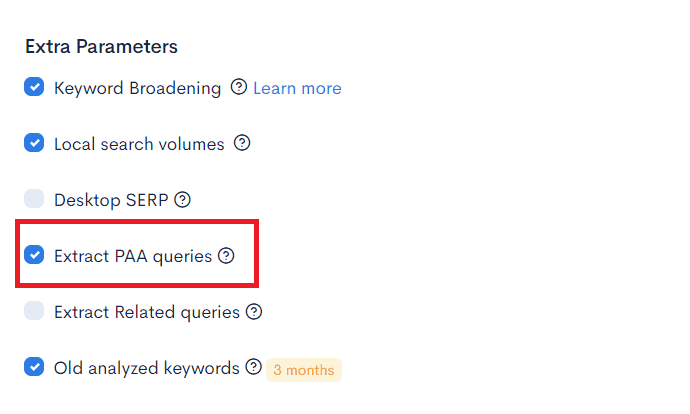
And here we are: LowFruits was able to generate 10961 keywords for us.
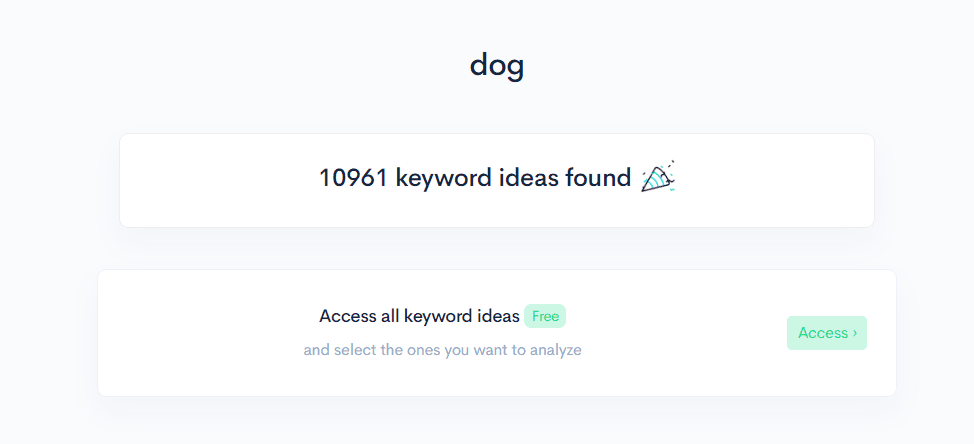
Step #3: Choose keyword topics and apply filters
Firstly, you want to fetch the keyword volumes for all of the keywords. You can do that at the upper right corner.
Next, we want to start filtering down on the keyword topics that we are not interested in and the keyword topic that we want to focus on:
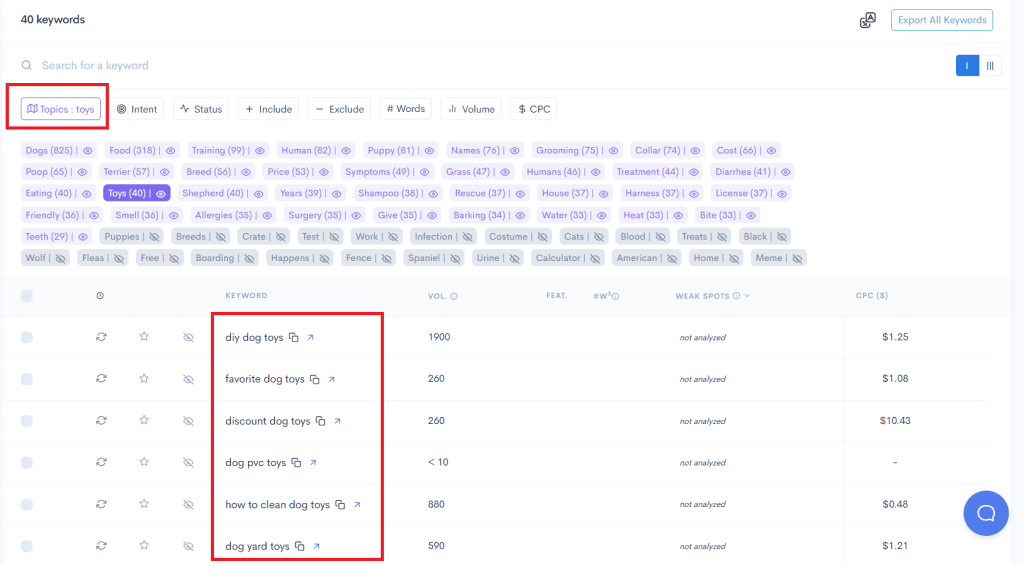
Let’s focus on dog toys. We were able to find 40 keyword ideas about dog toys.
Alternatively, if you were interested in finding profitable keywords, you could have filtered not by a keyword topic but by search intent (or both):
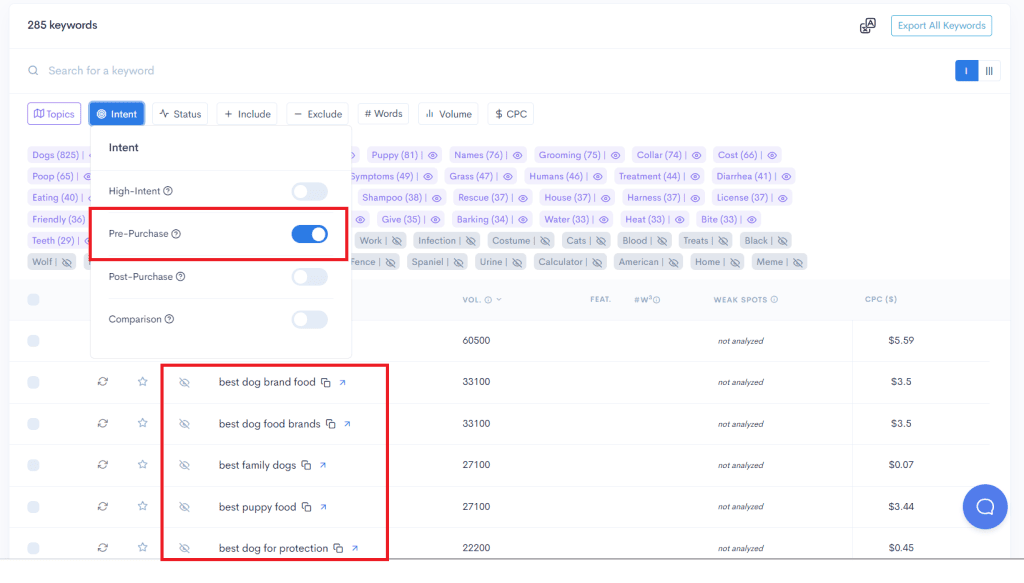
For the remainder of the pets niche topic, we can continue with the dog toys keyword ideas.
Step #4: Bulk analyze keywords SERPs with LowFruits
Now that we have come down to 40 keywords, we want to extract the keywords’ SERPs with LowFruits:

We were able to find which of these 40 keywords have weak domains ranking on the 1st page on Google for them.
And if you jumped straight onto this section, here is what the different fruits mean on the picture:
- Green fruits – Sites that have a domain authority of less than 20 (number can be customized) ranking on 1st page
- Blue fruits – User-generated content or forums, such as Reddit or Quora ranking on 1st page. These are pages that are not optimized for SEO
That means the keyword ”are dog toys scented” has:
- Quora (forum) ranking on 1st position
- 3 websites ranking for it on the 1st page that have a domain authority of 20 or less
Which means that even a newer website for dog toys would not struggle much to rank on the 1st page of Google for this keyword, given that they satisfy the search intent.
We can get bonus information for these keywords from LowFruits: the average word count for each of the topics.
On LowFruits, it costs 1 credit for every 1 keyword you analyze, but for extracting the average word count it costs no credits.
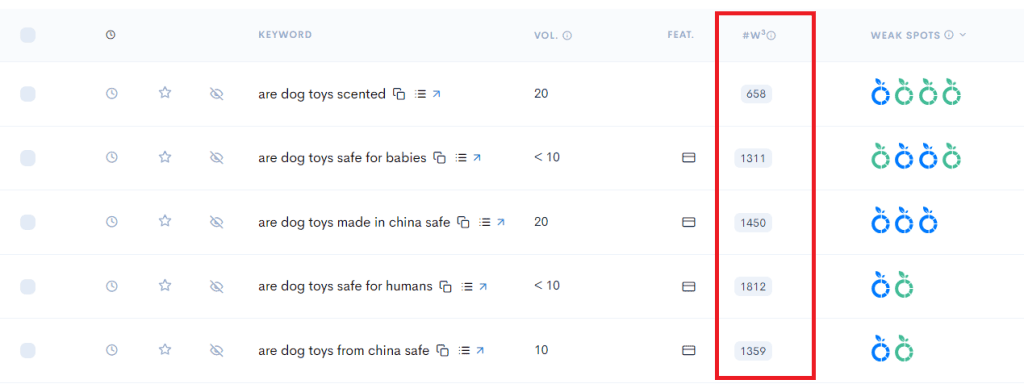
That would give us a rough estimate of how many keywords we would need to write ourselves in order to rank for these topics.
Step #5: Find competitors’ unoptimized keywords
The final step after we identify the low-hanging fruit keywords is to be able to prioritize them.
After you have extracted the SERPs of a keyword on LowFruits, you can then go and see which of these keywords have not been optimized for in the title tags:
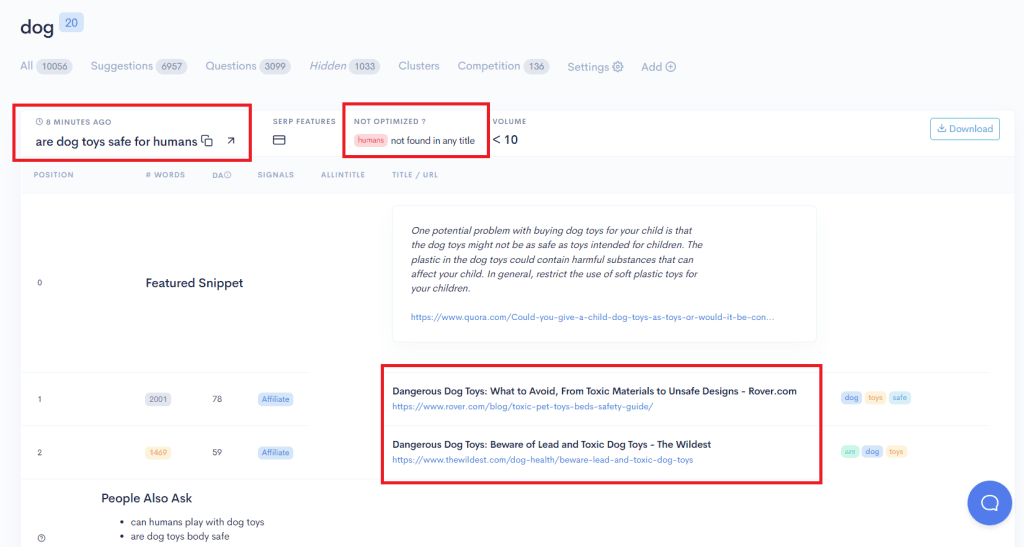
After expanding on some of the keywords that we analyzed, it can be observed that no competitor has optimized in their titles for the keyword ”are dog toys safe for humans”.
That means this keyword not only has 1 weak domain and a forum ranking for it on the 1st page but also nobody has optimized for it in their meta data.
And this is how you should go keyword by keyword from the low-hanging fruit to find the lowest-hanging fruits.
These will be the easiest keywords that you can go after.
This is how we were able to find 25 easy keywords in the pet niche for dog toys, and then further decide on the first 5-10 to focus on since the competitors have ranked for them as secondary keywords.
Conclusion & Key Takeaways
- In every niche, no matter how saturated, there are easy keywords to rank for – you just have to find them with the right process
- Extracting the People Also Ask (PAA) queries proves to be useful for finding easy keywords, as not many competitors have targeted them
- Filtering in keyword research tools is king – after finding the seed keyword, there should be rigorous filtering based on what the SEO is looking for
- LowFruits users can maximize the value of their credits by filtering down keyword topics and by hiding keywords they do not want to analyze
- Content marketers should not stop when they have a list of 40-50 easy keywords to go after, they should prioritize based on whether the competitors have properly optimized for these keywords
- Go after keywords that have ”weak competition” ranking for it on 1st page of Google – that includes low domain authority websites and forum pages.
Is there any other videos you have prepared showing step by step on how to use lowfruit for searching low hanging fruits? Help me please